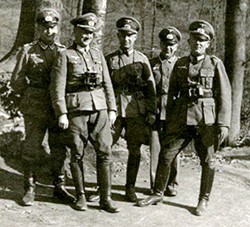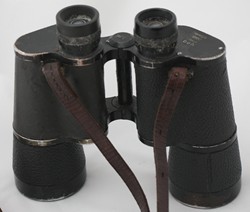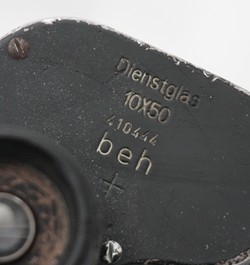Second World War (WW2) German binoculars

Introduction
Military binoculars and those used by the German military in the Second World War are amongst the most collectable vintage binoculars. Values can be up to £1000 for a U-boat captain's binoculars. At the other end of the scale, binoculars used by army officers and NCOs can be as cheap as £40 to £60.
There are two reasons for this. The first is a practical one. German-made binoculars were of outstanding quality. They are very usable as binoculars, once you adjust to the eye piece focusing which is used on most military binoculars.
Dienstglas binoculars were highly prized souvenirs for Allied Serviceman. After the War they became a desirable accessory and many found new owners via optical retailers and army surplus stores. For example, Peerless Camera Stores in New York offered Zeiss Dienstglas binoculars 10x50 for $97 and 6x30 for $38 in 1946.
The second reason is a continued fascination for items from the Second World War and from the Third Reich in particular.
Models
Binoculars used by the German military in the Second World War were made by a huge number of makers. The most well-known were Carl Zeiss, Ernst Leitz, Swarovski and Voightlander. Up to 1940 they carried the maker's name and as well as the word 'Dienstglas'which means service glass. From around 1940 the the maker's name was replaced by a three letter code.
There were three common types of binocular issued to the German military before and during the Second World War: 6x30, 7x50, 10x50.
6x30
The 6x30 was the type commonly issued to NCO and officers. According to 'Deutsche Soldaten' they were issued to the squad leader independent of rank.[1] They often had a graticule which is a series of lines in the right-hand lens. It was used to estimate distances. If you knew the size of a man or a truck that you could see with the binoculars, you could estimate the distance based on the number of lines it measured in the graticule. It was a technique that soldiers had to learn.
The graticules were sometimes removed from the binoculars if they were recycled for civilian use.
Early binoculars were made from brass. Later ones were made from an alloy of magnesium and aluminium, which was extremely light. Towards the end of the War binoculars were sometimes made from bakelite.
7x50
These are the classic night vision binoculars preferred by sailors. However, this spec was also used by the Wehrmacht (Army) and Luftwaffe (Air Force) as well as the Kriegsmarine (Navy). They are larger and usually the classic Zeiss shape.

10x50
These are the most practical size for modern applications such as bird watching or spectator sport. They give you powerful magnification and bright lenses.
They had specialised use in wartime and were possibly issued to artillary squadrons. Senior officers may have also used this type of binocular.
Field Marshal Erwin Rommel, the Desert Fox, used a pair of 10x50 Dienstglas binoculars. His have the bakelite eyepiece caps missing. Did he remove them to make the binoculars easier to use with his trademark goggles?
U-boat and Kriegsmarine binoculars
The 7x50 binocular was more suited to Naval operations. This is because lower magnification binoculars are more suitable for use on ships in rough weather.
The binoculars which command the highest prices on eBay are ones specifically designed for U-boat or at least naval use. They are finished in green/grey paint. They are much heavier in construction and have removable rubber armour.
Look out for:
- Grey/green paint finish
- Additional rubber around the eyepieces and objective lenses
- Heavy construction - some naval binoculars were heavy
- Circular prism case design
- Kriegsmarine eagle over a swastika
All of these add to the value. If you want to be 100% sure of its provenance then some documentary evidence would be needed.
Markings
Dienstglas

Binoculars used by the German military are marked 'Dienstglas' which means 'service glass'.
You do find some 6x30 binoculars that look identical to the Dienstglas ones, but do not have a maker's mark, a letter code or the word 'Dienstglas'. They are just marked 6x30. My thoughts are that these were made after the War for the surplus market from 1945 to 1950. I don't have any evidence for this other than the number of pairs advertised in US magazines just after the end of the War and the desire of the Allied powers to get Germany back on its feet economically.
They are less collectable than binoculars marked Dienstglass. Generally they come to market in very good condition and sell for around £50 for a good clean pair.
Maker's name or code
After 1940 the German military wanted to keep the manufacturers' names secret. I am not sure if the motivation was fear of allied bombing or to disguise manufacturers in occupied countries. There were letter codes which identified the manufacturer. The most commonly seen ones are:
- beh - Ernst Leitz GmbH, Wetzlar
- blc - Carl Zeiss, Jena
- ddx - Voightlander & Sons, Brunswick
- cag - Swarovski, Tyrol
- eso - Optische Werke G Rodenstock, Munich
For more information see German binocular manufacturer codes
Graticule - 'h/6400'
The presence of the graticule is indicated by 'h/6400'. Although some binoculars with the graticule do not have it. The Leitz binoculars on this page have the graticule but are not marked 'h/6400'.
Low temperature markings
Particularly after Germany invaded Russia in 1941 the Wehrmacht needed binoculars that could withstand cold temperatures. A number of markings exist that indicate lubrication with low-temperature grease.
- KF
- Blue circle or 'O'
- + or plus symbol
- Blue triangle
Other markings
- 'M' - stands for metric, it means metric screw threads
- 'T' - stands for transparenz - it means coated lenses
Colour and finish
Black is the most common finish. Some binoculars are just painted, others are covered with leatherette or leather.
Naval binoculars can be finished in a grey/green paint.
Later in the War a tan or sand colour was used for Army binoculars. However, this does not mean they were intended for use in the desert.
Price guide
- Spare parts - up to £20
- Cases - £40 to £200
- 6x30 binoculars - £40 to £300
- 7x50 binoculars - £140 to £400
- 10x50 binoculars - £80 to £500
- U-boat binoculars - £400 to £900
- Other Kriegsmarine binoculars - £300 to £500
Notes 6x30, 7x50 and 10x50
At the top of the price bands expect optically perfect lenses and very good cosmetic condition. It is possible to get usable examples at the low end of the price ranges though.
Notes - U-boat binoculars
U-boat binoculars will not be perfect, even at the top end of the price range.
Cases
Original cases are rare and can be worth as much as the binoculars. Early cases were leather. Later ones were made from bakelite.
Condition
Cosmetic conditon is not as important in value as in some collectables. Bear in mind that many of these binoculars will have been subject to war service, so will not be perfect. Ones that are damaged or are not usable as binoculars are best avoided though.
It is expensive to have binoculars serviced. These German binoculars can be particularly difficult to repair. Binoculars with collimation issues (double vision), mould inside the lenses or signifcant dirt inside the lenses should be avoided.
Binoculars that have been serviced recently will be worth significantly more.
References
[1] 'Deutsche Soldaten''Deutsche Soldaten' by Augustin Saiz, published by Andrea Press, 2008, pages 164-167
By Steven Braggs, January 2021


Comments
Hi
I have a set of Hensoldt Wetzlar with the letters DRP under the name. They also are 7 x 56 (not 50) and marked NACHT-DIALYT. Anyone have any history on these glasses?
I have attempted repeatedly to find information about other high quality German binocular brands, such as Steinheil, Schneider Kreuznach, Hertel and Reuss, Spindler and Heuer, and others. There is practically no useful anything, and the only brands really commented on are Leitz, Zeiss and Swarovski (Austrian). Comments by people on Cloudy Nights, etc. seem to be those of brand fanatics, braggarts re owning expensive items and those hardly interested in the truth. I have also read good references to Hartmann and Kern (Swiss), and ZI suspect that there are other very good products out there, but identifying them is impeded by a culture of indifference and silence toward a useful provision of information in this area. Serious and objective contributions are needed.
I've just seen an 8x30 set of binoculars for sale carrying three digit factory code/deinstglas/+ sign for extreme cold late ww2 by Carl Zeiss Jena.?I cannot find any information regarding 8x30 ever being produced during ww2,the only set i've ever come across.any help would be great.thank you.